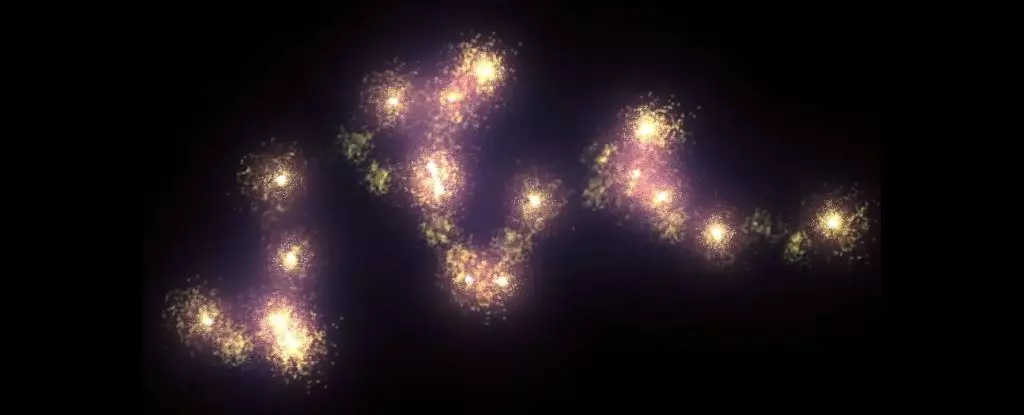Recent astrophysics findings are pushing the boundaries of our cosmological understanding, particularly regarding the Hercules-Corona Borealis Great Wall. If the implications of a thorough reevaluation of this colossal galactic structure hold true, we’re not merely reevaluating its size but also grappling with fundamental cosmic principles. Initially estimated at roughly 10 billion light-years, the dimensions of this gargantuan formation are now thought to extend to an extraordinary 15 billion light-years. Such expansion in perceived size is not just a semantic enhancement; it fundamentally alters our comprehension of the Universe’s structure and composition.
The Hercules-Corona Borealis Great Wall was conceived over a decade ago when an unusual concentration of gamma-ray bursts was detected. These bursts are the Universe’s most explosive events and take place in extreme cosmic scenarios, like the cataclysmic birth of black holes from collapsing stars. The gamma-ray bursts act as cosmic beacons, illuminating the locations of massive stars and galaxies. The association between these bright explosions and their hosting galaxies serves as a template for astronomers to map the Universe’s grand tapestry.
Gamma-ray Bursts: The Cosmic Messengers
These astonishing gamma-ray bursts, identified in diverse locations across the cosmos, have recently garnered increased attention due to their utility in mapping galaxy clusters. They are not only the brightest events in the Universe but also powerful indicators of the stellar populations normally associated within those clusters. The recent meticulous examination by the research team, which looks at 542 gamma-ray bursts with known redshifts, provides a clearer picture of the distance and distribution of the Great Wall.
Redshift measurements serve as a key indicator of distance, showing how the fabric of spacetime is stretching as the Universe expands. By analyzing light transformations from these distant bursts, researchers discern the magnitude of the Great Wall, revealing an astonishing span that immensity on an almost incomprehensible scale. This leads us to challenge not only prior constraints on this structure but also to confront the existing cosmological models that deem such vast arrangements statistically improbable.
The Crisis of Our Cosmological Models
What’s critically fascinating about the revised findings is the challenge they pose to the established cosmological principle, which asserts that the Universe should manifest a homogeneous structure when viewed over sufficiently vast distances. Deviations from this principle—like the Hercules-Corona Borealis Great Wall—pose significant questions about the Universe’s initial conditions and its subsequent evolution. Definitions of ‘normal’ within the cosmos may require reevaluation.
Previously, structures like the Quipu and Sloan Great Wall were already notable outliers at around 1.3 billion light-years, yet with the new findings, they barely begin to scratch the surface of the implications. In the historical context of cosmic structures, the Great Wall gleefully escalates the scale of true outliers, shifting the paradigm. As astronomers continue to discover even larger formations, they usher in a potential metamorphosis in our perception of cosmic evolution.
Unpacking the Wider Implications
Though answers on the larger implications of the Great Wall remain elusive, the investigation prompts a deeper exploration of how structures of such enormity impact our understanding of dark matter, dark energy, and the Universe’s expansion rate. Could the existence of these giant structures redefine theories about the formation of galaxies? What might they suggest about the clustering of matter in the early Universe?
This phenomenon of galactic aggregation has the potential to reveal unforeseen patterns and secrets about the cosmos—the kind of revelations that can redefine our place within it. Observational studies from organizations such as NASA and ESA could further unravel these mysteries, propelling us toward a new era of astrophysical inquiry.
While we have encountered a wealth of data and insights regarding the Hercules-Corona Borealis Great Wall, there remains a vast universe brimming with unanswered questions. These findings compel us to embrace the unknown and challenge the tenets of our cosmological models. The relentless pursuit of truth in the stars is a journey of growth, one that reveals more about our own planet and society, as we grapple with the enormity of the question: How did we get here, and where are we headed in an ever-expanding universe? With each new discovery, we inch closer to understanding the mysteries and secrets that the universe still holds close to its epicenter.

